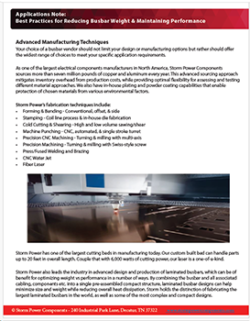Best Practices for Reducing Busbar Weight While Maintaining Ampacity and Performance
August 15, 2024 1:03 pm
Reducing the weight of busbars while maintaining ampacity (the ability to carry current) can be challenging, especially for applications where weight is a critical factor, such as aerospace, automotive, etc.
Some of the key considerations for reducing busbar weight include:
- Material Selection: Choose high-conductivity materials like aluminum or copper alloys that offer the
required ampacity but are lighter than traditional materials. - Optimized Cross-Sectional Design: Use a busbar design that optimizes the cross-sectional area. This
can involve optimizing the height to width (d/w) ratio and/or using hollow or composite structures that
maintain strength and conductivity while reducing weight. - Advanced Manufacturing Techniques: Employ advanced manufacturing methods to create optimized
busbar geometries that reduce material use while maintaining strength and conductivity. - Integrated Cooling Systems: Incorporate cooling channels or systems into the busbars to improve heat
dissipation, allowing for smaller cross-sections and reduced weight without overheating. - Strategic Layout and Segmentation: Optimize the layout of busbars and segment them where possible
to reduce overall weight while maintaining efficiency.
By addressing these key issues, it’s possible to achieve lighter busbars without compromising their ability to carry the required electrical currents.
This new Applications Note provides a deeper diver into the specific areas of materials choices, cross-sectional design, and advanced manufacturing techniques.
Download the App Note on Reducing Busbar Weight
Bus Bars | by Storm Power Team

Comments are closed here.